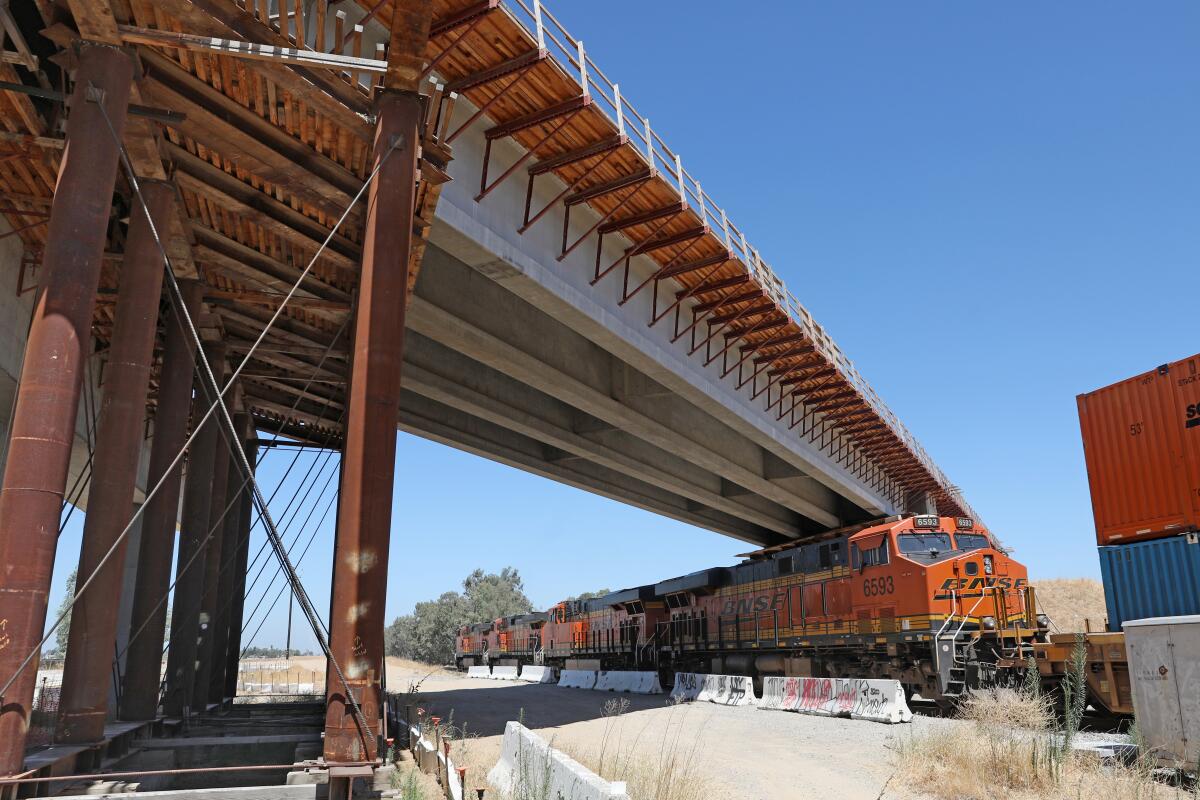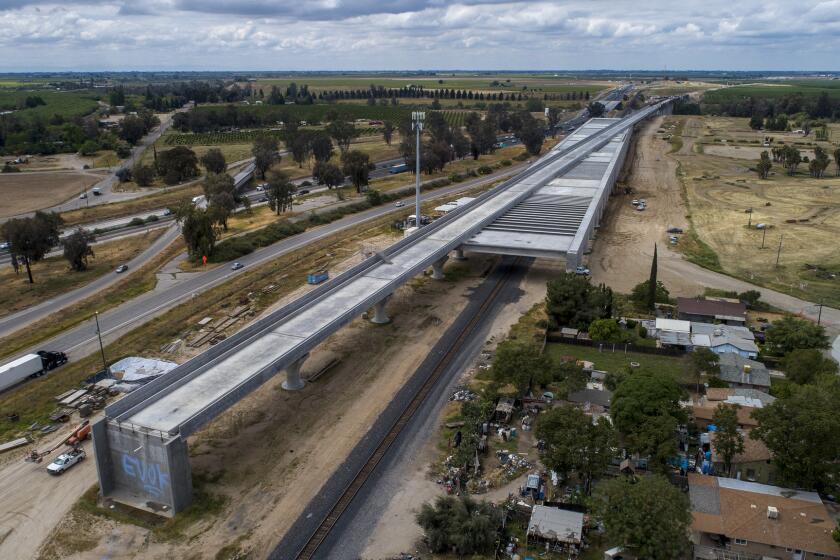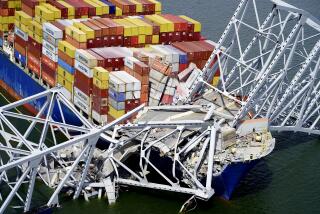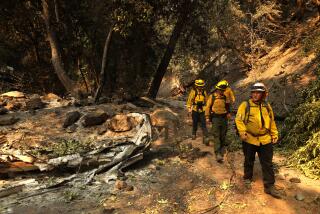‘Horrible sequence of mistakes’: How bullet train contractors botched a bridge project

A series of errors by contractors and consultants on the California bullet train venture caused support cables to fail on a massive bridge, triggering an order to stop work that further delayed a project already years behind schedule, the Los Angeles Times has learned.
The bridge is longer than two football fields and is needed to shuttle vehicles over the future bullet train right of way and existing BNSF freight tracks in Madera County.
Authorities have yet to finalize a plan to repair the bridge. Late last year, crews installed temporary steel supports to prevent it from collapsing.
Hundreds of pages of documents obtained by The Times under a public records request show the steel supports snapped as a result of neglect, work damage, miscommunications and possible design problems.
“It is a horrible sequence of mistakes,” said Robert Bea, emeritus professor of civil engineering at UC Berkeley and co-founder of its Center for Catastrophic Risk Management.
The bridge is part of a 31-mile stretch of construction under contract to Tutor Perini Corp., a major construction firm based in Sylmar.
The bridge is part of Gov. Gavin Newsom’s plan for a 171-mile, $20.4-billion bullet train operation from Merced to Bakersfield.
The bridge work began in 2016 and was supposed to be completed in 12 months. Relocation of underground utilities became a problem, as there were schedule glitches, according to rail authority and Madera County officials. Months turned into years, during which thousands of residents were forced to take long detours around the site.
Then last year came a series of blunders.
High-strength steel strands supporting the 636-foot-long structure began to snap on Oct. 22, one after another. Ultimately, 23 of the strands, which are composed of seven individual wires each, broke unexpectedly, according to rail authority documents and officials. The order to stop work was issued Nov. 4.
A forensic engineering analysis, obtained by The Times, found that the strands corroded from rainwater that had leaked into the internal structure of the bridge and then broke. The analysis was prepared for Tutor Perini by the forensic engineering firm Wiss, Janney, Elstner Associates of Northbrook, Ill.
In a statement issued after this story was published, Tutor Perini said that the breaks on the vent tubes “were small enough to not be seen, but large enough to allow water to intrude into the post-tensioning ducts.”
The statement went on to say that the proposed repair plan has been checked by an independent engineer and approved by the engineering staff of the rail authority. The cost was not disclosed, but the company described it as “nominal.”
Garth Fernandez, the rail authority’s interim director for the central region, said he was confident — based on the analysis, computations by designers and an inspection by Tutor — that once the bridge is repaired it would have its designed load-carrying capacity. But Bea, a member of the National Academy of Engineering, says a more comprehensive examination of the structure is needed to ensure its safety.
The problems on the Road 27 bridge reveal project management hitches that have dogged the bullet train for years. The California High-Speed Rail Authority has five separate layers of consultants and contractors on the bridge. Any one of them could have identified a long series of errors, but it appears no one did so.
Apart from those problems, the state issued a variety of nonconformance reports on the company’s work, including an instance where a crane boom hit part of the bridge construction, contaminated concrete was found in a bridge support pier, incorrect alignment occurred on a bridge pier, and steel dowel rods were missing in concrete, among other items.
Fernandez said the nonconformance reports showed that the authority’s quality control program was working, though he acknowledged, “We don’t like where we are right now.” The authority is moving to strengthen its oversight of the project with additional engineers borrowed from Caltrans, he said.
The California High-Speed Rail Authority has long wrestled with its dependence on consultants and outside experts, with a 2018 state audit faulting the agency for being overly reliant on these private interests.
When California shifted its bullet train plan into high gear in 2008, it had just 10 employees to manage and oversee design of the largest public construction project in state history.
Gov. Gavin Newsom told The Times in 2019 that he was “going to get rid of a lot of consultants,” but they remain integral to the project, according to engineering specialists and officials involved with bullet train planning.
“The layers on this project are onerous,” said William Ibbs, a UC Berkeley civil engineering professor who has consulted on high-speed rail projects around the world. “The levels of administration and review are very unusual. No one company is going to be wholly to blame if something goes wrong, because they can spread the blame around.”
“It isn’t getting any better,” said an executive at one firm working on the project, who asked not to be identified because he was not authorized to speak to the news media. “It is such a pillage of the taxpayers.”
Some outside engineers compare the situation to the 2018 Florida International University disaster, in which multiple players failed to recognize defects in a pedestrian bridge that collapsed onto a Miami roadway. On the Madera County project, there has been no bridge failure or casualties, but in Miami, six people were killed. Eight were injured.
“One of the criticisms of the Florida bridge collapse was the lack of responsibility up and down the chain of command,” said USC civil engineering professor Gregg Brandow. After reviewing the forensic report on the Road 27 bridge, Brandow said, “You have a hard time finding the actual chain of command. I don’t think you know who was responsible.”
On the Madera County bridge project, the reporting lines are complex.
Tutor Perini is the so-called design builder of the bridge, though its team member Parsons actually designed the bridge.
Tutor’s work is overseen by an independent check engineer, the New York-based firm STV. And Parsons’ work is partly reviewed by an independent site engineer, also STV.
Above STV is a so-called project and construction manager, a joint venture of Bay Area firms PGH Wong Engineering and Harris & Associates, which manages the day-to-day contract.
Above the joint venture known as Wong Harris is the state’s so-called rail delivery partner, Montreal-based WSP, which has broad oversight of the concept, design and execution of the project.
Finally, there is the state rail authority, a relatively small agency with problems of worker turnover. The authority currently has 220 employees but 51 vacancies and no permanent board chairman. Its chief engineer retired a few months ago but is on board as a post-retirement annuitant.
In this tangle of organizations, lines of communication are strained, which clearly played a role in the failure of the bridge supports.
The bridge over Road 27 is known as a post-tension structure, a fairly common type of design used in buildings, parking structures and bridges. High-strength steel strands are run inside ducts and then pulled to extremely high tension. After tension is added, the ducts are pumped full of grout to protect the steel strands.
The Road 27 bridge has five ducts in each of four girders, and the plan was to tension and grout three of them before the concrete roadway was poured and then apply tension to the strands in the other two afterward.
Before any strands were installed, the plan required that the ducts meet an air pressure test to assure that the grout would not leak. The pressure test failed to meet specifications, according to state documents. The failure might have been related to the design that had the ducts recessed from the ends of each girder segment, Fernandez said. There was some concern that if they tried to grout three of the ducts, the grout would migrate and fill the other two ducts, preventing installation of strands later.
Under its contract, Tutor was supposed to grout the ducts within 10 days of the strands’ installation in April. Tutor’s design firm, Parsons, wrote a “field change notice” that called for a delay in the grouting until all the strands in all of the ducts were installed, Fernandez said.
It was submitted to STV, where it sat. Fernandez and Christine Inouye, the rail authority’s director of engineering, said in an interview that STV never sent that notice to Wong Harris or to the rail authority.
“In hindsight, we all should have been aware of it,” said Fernandez. “Sometimes in a project of this complexity, these things happen.”
In April, the rail authority issued a notice of noncompliance to Tutor, saying its failure to grout the ducts violated its contract.
Former employees of the California high-speed rail project’s top consultant say they were punished for flagging problems and bringing bad news to their bosses.
An internal audit by the rail authority, finalized on June 1 and obtained by The Times under its public records request, found that 72% of STV’s contract requirements that were examined had nonconformances. The specific findings faulted the company for not being on site at critical times, failing to file required reports and not having qualified personnel on the job, as well as other inadequacies.
STV said in a statement that it was working with the authority and Tutor Perini on the “safety of all structures” and referred questions to the rail authority.
The decision to delay grouting might have been OK if vent caps on the ducts had not been damaged and it had not rained. But crews that installed rebar on the highway deck apparently damaged those caps, and it appears that nobody, including STV or Wong Harris or Tutor Perini, noticed. When crews later drained the ducts after the failure occurred, water “poured out” of one duct for five minutes, according to the forensic report.
The report found that the strands failed as a result of “stress corrosion cracking.” Brandow noted that the strands had begun to corrode even before they were installed, according to the forensic report. He said even minor corrosion on strands could initiate cracking.
The repair plan for the bridge calls for all the strands in all of the four girders to be replaced, Fernandez said. Tutor had started to replace some of the strands shortly after they broke and was told it had to replace those a second time, according to a letter. The plan is currently being reviewed by BNSF headquarters, which has the right to examine any work that occurs over its tracks.
Fernandez said Tutor would have to pay for the cost of the repairs.
In its statement, Tutor Perini said the repair is “the contractual responsibility of the rebar subcontractor.” The company did not disclose the name of the subcontractor.
More to Read
Sign up for Essential California
The most important California stories and recommendations in your inbox every morning.
You may occasionally receive promotional content from the Los Angeles Times.












